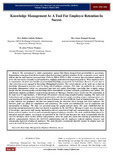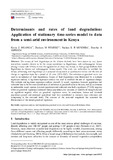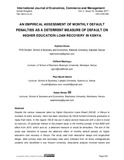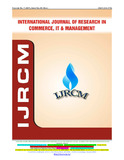School of Business & Economics (JA): Recent submissions
Now showing items 261-280 of 405
-
Employee Perceptions on Transformation Leadership: A Case Study of Kenyan Public Universities
(International Review of Social Sciences and Humanities, 2014) -
Emotional Intelligence Influence on Employee Engagement Sustainability in Kenyan Public Universities
(International Journal of Academic Research in Public Policy and Governance, 2014)Organizations the world over face challenges today which require reforms in the management and governance styles. Therefore the organizations continue to attempt to achieve more for less by creating and maintaining value ... -
An Assessment of Social Media Usage among TVET Students in Kiambu County, Kenya
(International Journal of Novel Research in Interdisciplinary Studies, 2018)This study was carried out to assess the use of social media among the students of TVET institutions in Kiambu County. In the context of today’s electronic media, social networking sites have come to mean individuals, using ... -
Factors Affecting Internal Auditor’s Performance in Public Universities in Kenya
(Global journal of Economics and Business Administration, 2018)The study focused on the factors affecting internal auditors ‘performance in public universities in Kenya. It aimed at achieving the objectives: to determine how the working environment, to assess how the challenges to the ... -
Determinants of Insurance uptake in developing countries: Evidence from CIC insurance, Kericho Branch, Kenya.
(International Journal of Scientific and Research Publications, 2017)Insurance plays a major role in the life of the humanity. The citizenry has gradually come to realize the necessity of insurance and these needs are unending as long as life exists. The purpose of this study was to ... -
Effects of occupational strain among poiice officers to the general security of a community: a case of muranga town, muranga county, Kenya
(Advances in Social Sciences Research Journal, 2018)Strain at work in any profession negatively affects the people working and overall performance of employees. This in turn has a negative impact on production or quality of services being offered. This applies to police ... -
Effects of Stakeholders‟ Participation in the InterEthnic Conflicts and Economic Growth in Nyando, Muhoroni and Tinderet Sub-Counties
(International Journal of Science and Research (IJSR), 2018)The impact of ethnic conflicts to economic growth has been of great concerns by many Nations globally. Africa is the most affected continent in regard to conflict due to many nations within the continent experiencing ... -
FACTORS INFLUENCING TRAINING COSTS IN UNIVERSITY COLLEGES IN KENYA: A CASE OF MURANG’A UNIVERSITY COLLEGE
(2018-06)The study sought to find out the factors influencing training costs in university colleges in Kenya a case of Murang’a University College. This was occasioned by the fact that the university colleges charge different amounts ... -
RELATIONSHIP BETWEEN FARM PRODUCTION CAPACITY AND AGRICULTURAL CREDIT ACCESS FROM COMMERCIAL BANKS
(International Academic Journal of Economics and Finance, 2018)In Kenya and across the globe, the proportion of commercial bank’s loans the agricultural sector relative to other sectors is generally low. This is despite the considerable financial intermediation opportunities resulting ... -
Influence of Technology Adoption on Credit Access among Small Holder Farmers: A Double-Hurdle Analysis
(Africa International Journal of Management Education and Governance, 2017)The proportion of bank lending to the agricultural sector is generally low across the globe, and the situation is no different in Kenya. This is despite the fact that commercial banks have continued to launch tailor-made ... -
EFFECTS OF INTER-ETHNIC CONFLICTS AND ECONOMIC GROWTH IN NYANDO, MUHORONI AND TINDERET SUB-COUNTIES
(2018-03)Inter-ethnic conflicts impact negatively on the economic growth. In Africa, it has cost the Continent a tune of $ 120 billion, specifically affecting the agricultural sector subjecting over 198,000,000 people to starvation ... -
Factors Affecting The Choice Of Promotional Mix By Commercial Banks In Kenya: A Case Study Of Kenya Commercial Bank Limited
(2018-03)Faced with intense competition in the market, commercial banks have engaged in aggressive marketing. This entails increased annual allocation for marketing promotion and competitive pricing of services. However, with reports ... -
Knowledge Management As A Tool For Employee Retention In Saccos
(2018-03)The environment in which organizations operate has clearly changed from predictability to uncertainty. Organizations want more from the best workers than their presence and their retention. In the co-operative sector, ... -
The Double Edged Role of Indigenous Languages in National Development: A Case of the Lower Primary Classroom in Kenyan Schools.
(2017)Language plays a fundamental role in the education outcomes of a country. The study has addressed the issue of language choice and development in a multilingual state to enable learners be advantaged both locally and ... -
Code switching between Agglutinative and Non-agglutinative Languages: A case of Kiswahili and English Verb during English Language Lesson.
(Scholars Academic and Scientific Publishers, 2017-11)Research shows that code switching plays a critical role in not only language development but also content delivery. The current study has addressed the issue of code switching in an agglutinative and non –agglutinative ... -
PREFERED HABITAT THEORY
(International Journal of Contemporary Applied Sciences, 2016)Preferred Habitat Theory is a theory on the investing behavior of bond buyers. It states that individual investors have a preferred range of bond maturity lengths, and will only go outside of this range if a higher yield ... -
Determinants and rates of land degradation: Application of stationary time-series model to data from a semi-arid environment in Kenya
(Springer, 2018-02)The causes of land degradation in the African drylands have been shown to vary. Some researchers consider climate to be the major contributor to degradation, with anthropogenic factors playing a minor role. Others reverse ... -
An Empirical Assessment of Monthly Default Penalties as a Deterrent Measure of Default on Higher Education Loan Recovery in Kenya
(International Journal of Economics, Commerce and Management, 2017)Despite the various measures taken by Higher Education Loans Board (HELB) in Kenya to increase its loans recovery, there has been reluctancy by HELB funded University graduates to repay their loans. In this regard, HELB ... -
The Effect of Socio-Economic Factors on Public Health Service Delivery in Kenya (A Case of Murang’a County Hospitals)
(INTERNATIONAL JOURNAL OF RESEARCH IN COMMERCE, IT & MANAGEMENT, 2017)Good health care is a fundamental need in the life of a person because it helps develop a positive self-image and also opens up the opportunities for the individual to do their daily duties as required of them. The study ... -
Effect of board size on the financial performance of merged institutions
(Ajpo Journals, 2016)Purpose: The purpose of this study was establishing the effect of board size on the financial performance of merged institutions. Methodology: The study adopted a mixed methodology research design. The study population ...




















